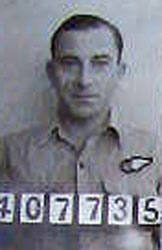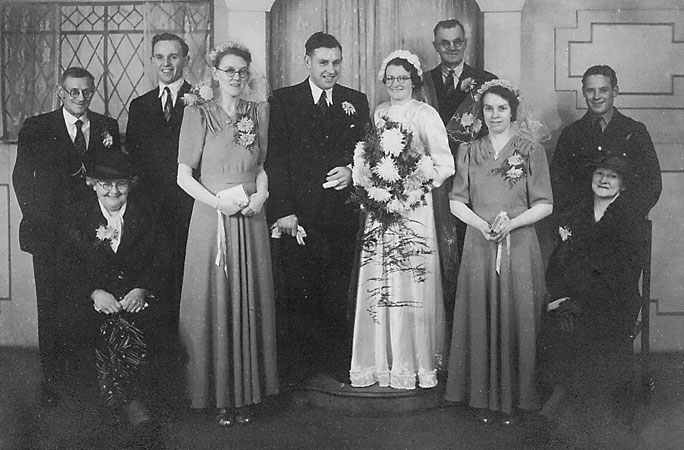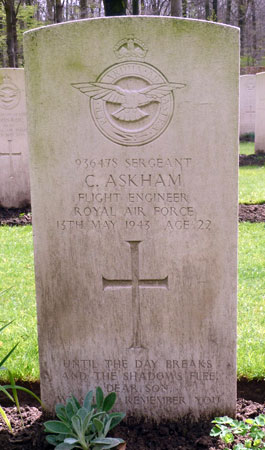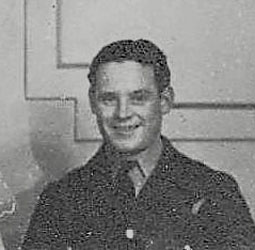This 460 Squadron aircraft took off from Breighton airfield at 17.15hrs on 21st December 1942 to undertake an operational flight to bomb Munich, they bombed the target area at 21.14hrs from 10,000 feet and made for home. They spotted a Junkers Ju88 at just after 23.00hrs which was in the process of making an approach to attack them, the pilot of the Lancaster put the aircraft into a diving turn to port by the Ju88 followed them and made it's attack from 50 yards. The Lancaster was hit in the port wing and rudder in this action but the Lancaster's mid and rear gunners returned fire and strikes were seen to hit the Ju88. The pilot of the Lancaster then flew into cloud and the Ju88 was not seen again. A safe return to Breighton was made and they landed at 02.06hrs.
Pilot - F/Sgt Peter Stuart Isaacson DFM RAAF (401068).
Bomb Aimer - Sgt Edward Eugene Wertzler RCAF (R/70619), of Red Deer, Alberta, (or Regina, Saskatchewan?) Canada.
Navigator - F/Sgt Lawrence Matthew John Evans RAAF (407735), of York, Western Australia.
Flight Engineer - Sgt Clarence Askham RAFVR (936478), of Armley, Leeds, Yorkshire.
Wireless Operator / Air Gunner - Sgt Erle Melville Copley RAAF (406434), of Perth, Australia.
Air Gunner - Sgt Joseph Grose RAAF (416117), of Rose Park, South Australia.
Air Gunner - Sgt John Kenneth Swain RAAF (407994), of Cammeray, New South Wales, Australia.
On 4th / 5th January 1943 this crew were flying Ops to Essen in Lancaster W4818 when they were attacked by an enemy aircraft and Sgt Wertzler was wounded in both legs. The hydraulics operating the bomb bay was damaged as was its bomb release electrics and other areas of the fuselage were also damaged. The aircraft made a landing at Coltishall on return and the bomb aimer was admitted to hospital. It was his last operational flight and he was replaced in this crew. The above crew, plus others to make up a Lancaster crew, were posted to 156 Squadron PFF in late-January 1943. In Lancaster R5912 on Ops to Berlin on 1st March 1943 with 156 Squadron they were over the target and had just dropped their markers when incendiaries dropped from another aircraft above hit their Lancaster's mid-upper turret. The bombs lodged in the aircraft and had jammed the elevator cables. The Lancaster then dived out of control but was eventually pulled out of its dive by P/O Isaacson with help from other members of the crew pulling on the control column. As a result of the high speed dive what was left of the mid-upper turret had broken away and the air speed indicator had stuck at its maximum limit. Joe Grose had got inside the aircraft after being wounded. The aircraft would not climb above 4,000 feet and the engines were not operating correctly, from Berlin they headed roughly west but uncertainly of their starting position drifted into the area of the Ruhr and all the ground defences that existed. The aircraft was flown from here, at roof-top height, through a barrage of searchlights and flak clear of the Ruhr. They crossed the North Sea and landed at Warboys where Joe Grose was hospitalised.
On 22nd May 1943, F/Lt Isaacson, F/Lt Nielson, P/O Copley and F/Sgt Grose were part of an eight man crew that took off in Lancaster ED930 from Prestwick in Scotland to fly to Australia. Using a route via Montreal, Ottawa, San Francisco, Hawaii and Canton Island to Brisbane they made it on 4th June 1943 and then flew the aircraft to Sydney. They also became famous for flying the Lancaster underneath the Sydney Harbour Bridge while on a trip around Australia to raise funds for the War Effort and took it to New Zealand and back. Peter Isaacson was awarded the Air Force Cross for part of this feat and further details are given in his biog below. He also has recorded his memories of each individuals in his crew and the basics below is drawn from those accounts.
Peter Isaacson was born 31st July 1920 in London, England. For service with 460 Squadron he was awarded the DFM, Gazetted on 6th November 1942, the citation reads.."This captain of aircraft has taken part in many successful night attacks, showing a fine offensive spirit and great determination. Sgt Isaacson is an ideal leader, who, by his courage, skilful pilotage and cool judgment, holds the complete confidence of his crews."
Having completed a Tour with 460 Squadron he was posted to 156 Squadron PFF and was awarded the DFC, Gazetted on 30th March 1943, the citation reads.."One night in March 1943, this officer was detailed for an attack on Berlin. Following the attack and while still over the target area, this aircraft was hit by anti-aircraft fire and severely damaged. The mid-upper turret frame was twisted, the perspex and two engine cowlings blown off, the aileron controls damaged, and the aircraft forced down to 4,000 feet. On the return journey the aircraft was driven off the route and held in a cone of searchlights for 15 minutes; during this time a further loss of height down to 900 feet occurred. In the face of this perilous situation P/O Isaacson, showing coolness, resolution and skilful airmanship, succeeded in flying his aircraft back to base."
He was also awarded the Air Force Cross, Gazetted on 27th August 1943 while Acting F/Lt. The citation for this award reads.."Flight Lieutenant Isaacson was captain of the Lancaster aircraft which recently flew from England to Australia via the Pacific and subsequently carried out direct flights between Melbourne and New Zealand (both ways). This is the first occasion on which an aircraft has flown to Australia by this route and the direct flights between Melbourne and New Zealand are the first of their kind."
Post-War he ran the news publishing companies including the "Southern Cross" and the "Sunday Observer" newspapers in Melbourne and the Asian Business Press Group. He was also an honorary aide-de-camp to The Queen from 1963 to 1965. In 1991 he was made a Member of the Order of Australia for services to the print media and the community. His biography "Pathfinder" was written by Denis Warner.
Bill Copley was born on 27th September 1914 in Broad Arrow, Western Australia, he enlisted in Perth. He was later awarded the DFM, Gazetted on 12th March 1943 and presented on 19th February 1945 at Government House, Perth on 19th February 1945. The citation makes mention of the incident recorded at the top of this page; it reads.. "Throughout his operational career F/Sgt Copley has displayed a highly commendable keenness and devotion to duty. In August 1942, during an attack against Kassel, he acted as fire controller whilst being attacked by enemy aircraft. His efficient orders enabled the rear gunner to hit the enemy aircraft, and his captain to take effective evasive action." He died on 8th July 1997.
Joe Grose was born on 10th September 1921 in Rose Bank, South Australia and enlisted in Adelaide. He was posted in to 460 Squadron as a spare gunner but became a regular in Issacson's crew but had not been through OTU training as was regular for Bomber Command airmen. He survived the crash of Lancaster R5912 on 1st March 1943 at Warboys airfield. He survived the War.
Edward Wertzler was living in Red Deer, Alberta, Canada when he enlisted in Regina, Saskatchewan on 24th August 1940. He was awarded the DFM for service with 460 Squadron, Gazetted on 2nd February 1943 and presented at Buckingham Palace on 18th May 1943. The citation for his DFM reads.. "On the night of the 4th January 1943, this airman was the air gunner of an aircraft which attacked a target in the Ruhr. Shortly after leaving the target area the aircraft was attacked by an enemy fighter. Sergeant Wertzler was wounded in the right leg and although his turret became unserviceable, he resolutely manned his guns until the attacker was eventually shaken off. Meanwhile, a fire had broken out in the bomber, but Sergeant Wertzler put out the flames with extinguishers despite a painful injury in his eye caused by one of the extinguishers exploding accidentally. This airman has displayed great courage and initiative in harassing circumstances." The incident in January 1943 ended his flying days he remained in the RCAF but took a desk job.

Lawrence Evans was born on 3rd October 1919 in York. He was working as a compositer in Adelaide when he enlisted in Adelaide on 4th January 1941. After completing his basic training he arrived at 460 Squadron on 20th June 1942. Sgt Evans had survived the ditching of Wellington R1695 on 10th September 1942 off Cromer on return from Ops to Dusseldorf. He was one of two survivors of the crew of five. He survived with bruising and suffering from exposure. He was admitted to RAF Hospital Rauceby for week and returned to his unit. He then converted to Lancasters and remained with 460 Squadron until 10th May 1943 when he was posted to 12 OTU. From there he was given notice that he was to be returning to Australia to joined an RAAF squadron. He later flew with 14 and 8 RAAF Squadrons and received his commission on 11th March 1945.
John Swain was flying in Lancaster W4817 on 27th/28th January 1943 on Ops to Dusseldorf and failed to return. The whole crew were sadly killed when the aircraft crashed in Germany and they are now buried in Rheinberg War Cemetery. F/Sgt Swain was thirty years old.



On 19th December 1942 Clarence Askham attended his sister Elsie's wedding in Armley, Leeds. His sister and, what would later turn out to be air historian, Graham Sharpe's mother worked together and she was a bridesmaid at Elsie's wedding. The photographs shown above are Graham Sharpe's. On 17th / 18th January 1943 Sgt Askam was flying in Lancaster W4816 on Ops to Berlin, the aircraft was damaged by flak over Stettin. The aircraft ran out of fuel and just after crossing the Yorkshire Coast in the Flamborough area the crew baled out. Sadly one member of the crew, Sgt Corfe, was killed when his parachute failed to open correctly. The rest of the crew survived. The aircraft is believed to have crashed into the North Sea just off the Yorkshire Coast. Clarence Askham was later posted to 156 Squadron PFF with other 460 Squadron aircrew for Pathfinder duties. On 13th May 1943 he was flying in Lancaster ED837 on Ops to Duisburg when the aircraft crashed in Germany after colliding with another aircraft over the target. He was twenty two years old and is buried in Reichswald Forest War Cemetery. His name was not spelt "Askam" as quoted in numerous locations on the internet.
Lancaster W4329 was built to contract B.69274/40 by A.V.Roe and Co.Ltd. at Chadderton and was awaiting collection in October 1942. On 23rd October 1942 it was taken on charge by 460 Squadron at Breighton and was originally coded "UV-T". On 22nd December 1942 it was attacked and damaged by a Ju88 while on Ops to Munich, despite damaget to the port wing and rudder the then pilot was able to bring the aircraft home where Cat.A(c)/FB damage was the damage assessment. It was repaired by a team from A.V.Roe with work commencing on 30th December 1942. It took exactly a month for it to be returned to 460 Squadron at Breighton. On 3rd February 1943 it received unspecified damage that required a further repair on site at Breighton. On 8th February 1943 it was returned to 460 Squadron but it's squadron code changed to "UV-K". As a result of flak damage sustained on the night of 27th / 28th March 1943 Cat.A/FB damage resulted and it was repaired on site. On 14th May 1943 460 Squadron moved to Binbrook and their squadron code prefix changed, so this aircraft became "AR-K". On 13th June 1943 it failed to return from Ops to Bochum which saw it's then crew of seven killed. Cat.E(m) damage was recorded on the paperwork and it was written off.